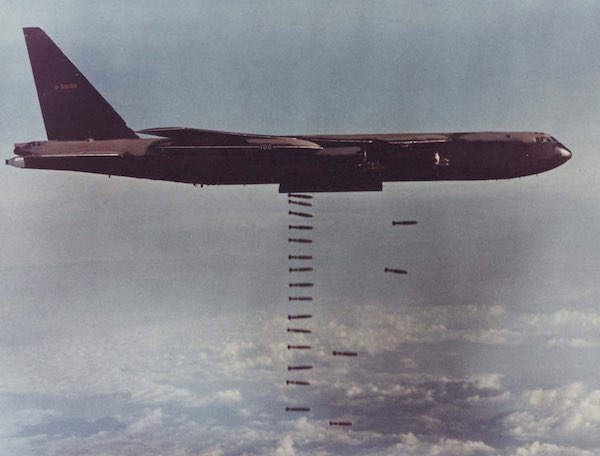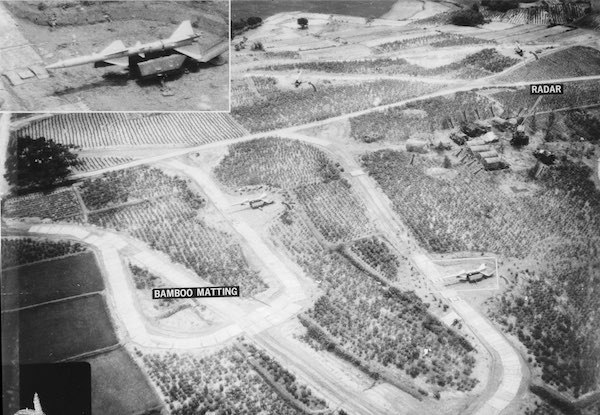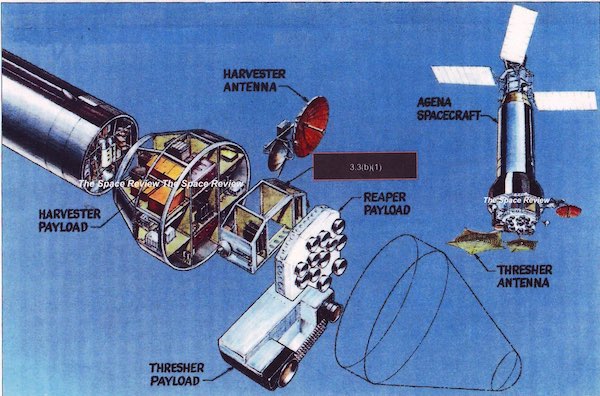The wizard war in orbit (part 3)SIGINT satellites go to warPENDULUM: MULTIGROUP goes to warThe MULTIGROUP 3 satellite, also equipped with SETTER 1B, was launched on January 17, 1967, into a 75-degree, 455-by-534-kilometer orbit, essentially equivalent to its predecessors. MULTIGROUP 3’s Agena spacecraft was equipped with improved solar arrays and batteries and these improvements enabled the satellite to produce data for almost 15 months. MULTIGROUP 3 had also been reconfigured to make the payload more capable of detecting anti-ballistic missile and anti-satellite radars, although the details remain classified. Apparently these modifications had originally been proposed for MULTIGROUP 2, but that spacecraft was too far along with development and testing to make the change.
One advantage of MULTIGROUP compared to earlier satellites was that the payload could be adjusted during each orbital collection pass in order to adapt to new information. Apparently this was possible with the earlier spacecraft, but MULTIGROUP had increased flexibility to respond to new requirements. The National Reconnaissance Office also implemented a new process for tasking the satellites known as “ITEMY” messages. ITEMY combined input from both the National Security Agency and the National Reconnaissance Office. Apparently the NSA and NRO were alerted to upcoming Soviet activities through the Defense Special Missile and Aerospace Center (DEFSMAC), and this occasionally enabled them to focus the MULTIGROUP satellites on these specific activities, although the details, like many other aspects of signals intelligence operations during this time, remain classified. This flexibility may have been what led to a new activity, called “PENDULUM,” the use of Program 770 satellites in direct support of the Vietnam air war. Throughout 1967 the US Air Force and the Soviet advisers who supported North Vietnam’s SA-2 surface to air missile forces had engaged in a struggle: the Soviets to enhance the SA-2’s ability to shoot down American aircraft, and the Americans to negate the SA-2. According to Steven Zaloga, writing in Red SAM: The SA-2 Guideline Anti-Aircraft Missile, over time the Americans had gained the upper hand, degrading the SA-2’s performance to the point where the North Vietnamese were launching on average about two dozen missiles to shoot down a single aircraft. Often the missiles flew out of control as soon as they left their launchers. The Soviets had been shocked by this poor performance and implemented new equipment and changes in tactics, including optically guiding the missiles and keeping the radars off when they thought that an American Wild Weasel aircraft was in their vicinity. In spring 1968, when MULTIGROUP 3 had been in orbit for a few months, data on SA-2 surface-to-air missiles and other defensive radars in Vietnam became a high priority, leading to the creation of an activity designated “PENDULUM.” Available records do not indicate how or why PENDULUM was started, but on March 31, 1968, Lyndon Johnson had announced a halt to bombing of North Vietnam. This undoubtedly reduced American aircraft sorties over the north and reduced the collection of intelligence on the location of the mobile SA-2 missile batteries, so PENDULUM may have been started as an effort to close the gap in intelligence gathering, reporting on any SA-2 radar system in North Vietnam that started emitting. MULTIGROUP 3’s improved capabilities made this possible. There is limited information on PENDULUM, but it appears to have been a program for providing signals intelligence data directly to forces deployed in Vietnam, making it possibly one of the first examples of a highly classified national intelligence satellite program being employed for tactical battlefield use. How exactly this was accomplished remains classified, but the Naval Research Laboratory’s POPPY signals intelligence satellite used mobile ground stations located in trailers to receive signals, and it seems likely that some kind of ground station was deployed to South Vietnam air bases to receive signals from the MULTIGROUP satellites. One declassified document refers to the deployment of mobile units on the periphery of the Soviet Union to assist in better tuning satellites collecting signals over Soviet territory in real time. This may have led to an effort to develop mobile read-out capability for MULTIGROUP, as opposed to relying on ground stations in the United States. MULTIGROUP was less successful as an operational concept than its designers had planned. The engineers had expected that interchangeable receiver and antenna modules would provide for more flexibility before launch. But both the subsystems and systems still had to be tested and qualified. Once they had been tested (vacuum, thermal, mechanical, and electrical) the receiver and antenna module could not be changed for different frequency coverage without repeating the testing process. Thus the payload configuration had to be determined six to eight months in advance and intelligence requirements could change faster than that. This may be the explanation for why the upgrades incorporated into MULTIGROUP 3 had not been included in the second satellite.
STRAWMAN: the last of the Program 770 Agena SIGINT satellitesThe last of the Agena-based low orbit multipurpose signals intelligence satellites was named STRAWMAN. STRAWMAN was proposed to the Director of the National Reconnaissance Office Al Flax on April 1, 1966. Flax approved long-lead-time items on June 6, 1966, and fully approved the project in September. Although details are still limited, ultimately five STRAWMAN spacecraft were approved for construction. It appears that throughout the 1960s, with the exception of the first satellite that was assembled from leftover parts from a Samos F-1 satellite, the National Reconnaissance Office purchased Agena SIGINT satellites in blocks of four: four Samos F-2s, four Samos F-3s, and four MULTIGROUP satellites, reduced to three in return for the addition of a fifth STRAWMAN satellite. Each STRAWMAN satellite had multiple payloads that changed during the course of the program:
REAPER, which was apparently the descendant of BIRD DOG and SETTER, consisted of a nest of helical antennas. THRESHER was partially tucked under REAPER and had two deployable mesh antennas. The overall payload was larger than previous Agena signals intelligence satellites. Up to this point all of the Agena-based satellites had payload fairings with the same five-foot maximum diameter of the Agena itself. But STRAWMAN had a more bulbous payload fairing that bulged outward to accommodate the greater number of antennas.
The first two STRAWMAN satellites also carried an auxiliary payload called CONVOY to determine detailed characteristics of Soviet anti-ballistic missile radars. Details about CONVOY remain classified and it is unknown if it was focused on the HEN HOUSE radars or a suspected anti-ballistic missile SA-5 site at Tallinn in Estonia. The fourth mission carried the HARVESTER payload that had two dish antennas that folded out to one side of the downward-looking spacecraft. All payloads that were part of STRAWMAN—THRESHER, REAPER, CONVOY and HARVESTER—were connected to a “pre-detection” analog recorder in the prime payload. What exactly this means is unclear, but The SIGINT Satellite Story implies that the satellites were able to turn on their recorders before they detected the signals, perhaps by turning on the recorder at the first hint of a signal before it passed a specific threshold that counted as a detection. Like its predecessors, STRAWMAN launched from Vandenberg on a Thor Agena-D rocket with CASTOR solid rocket boosters. The Agena fired its rocket engine twice, first in its role as second stage for the launch vehicle, then to circularize the satellite’s orbit. After the nose fairing had been jettisoned, the vehicle pitched down 90 degrees and deployed its antennas. Finally, a set of three solar panels deployed from the Agena’s aft rack. The first STRAWMAN launch took place on October 5, 1968. The spacecraft lasted over a year, twice the planned lifetime. STRAWMAN 2, launched on July 31, 1969, operated for over 13 months. The success in orbit of the first two missions resulted in the engineers projecting nine-month lifetimes for the next two missions, but even this proved conservative. STRAWMAN 3 operated for 18 months after being launched on August 26, 1970. The final satellite, STRAWMAN 4, was launched on July 16, 1971. A declassified image of the STRAWMAN 4 payload (the only one to carry THRESHER, REAPER, and HARVESTER) included a small antenna whose label is deleted, indicating that it had one additional still-classified payload. STRAWMAN 4 lasted more than 20 months. But during the mission the antenna connector to the lower band antenna of HARVESTER failed, eliminating any chance to intercept 5 gigahertz signals from the SA-5 surface-to-air missile system at Tallinn, Estonia, that some analysts suspected was part of an anti-ballistic missile system. The SA-5 at Tallinn had proved to be an enigma to American intelligence analysts because it was apparently designed for high-speed intercepts of high-altitude targets. Other than the Mach 3 A-12 OXCART reconnaissance plane, which did not overfly Soviet territory, there was nothing else for the SA-5 to shoot at. Tallinn also was not a sensitive location worthy of such a defensive system, leading to speculation that the missile site was part of an ABM system. Over time American intelligence analysts determined that the SA-5 was not an anti-ballistic missile, but it still remained puzzling. What they did not realize until much later was that the SA-5 had initially been developed to intercept the Air Force’s B-70 Valkyrie bomber. Even though the B-70 was cancelled, the Soviets continued the SA-5 for a high-altitude high-speed bomber threat that never emerged. The THRESHER digital electronic order of battle collection and processing system produced radar locations with 15-mile (24-kilometer) accuracy. THRESHER 2 produced 9,444 radar locations. THRESHER 3 produced 11,519 radar locations with 15-mile accuracy in its first four months of operation. REAPER 3, also on the same STRAWMAN mission, produced 33,915 locations with 5-mile (8-kilometer) accuracy. The intelligence return from these missions had turned into a flood, straining the ground processing systems. The PENDULUM effort to provide intelligence data to forces in Vietnam continued, with reporting from the THRESHER/REAPER payloads. This intelligence was reported less than 24 hours from time of intercept, with average time from collection to reporting being about 5.5 hours. During 1969 there were 41 PENDULUM reports and 183 in 1970.
The end of the Agena SIGINT satellite programThe STRAWMAN satellite program proved to be quite successful with only one major subsystem failure of any of the four vehicles launched. By the early 1970s, the National Security Agency expanded its Fort Meade processing facility to handle increased volume of data from the POPPY and other missions. STRAWMAN, THRESHER, and REAPER data was processed by Lockheed Missiles and Space Company, possibly at a still-classified site then located at the Navy’s Moffett Field, south of San Francisco. How and why responsibility was divided between the NSA in Maryland and Lockheed in California remains unclear. Strategic Air Command had been involved in BIRD DOG and SETTER processing, but it is unclear if it was also involved in REAPER processing. Clearly with the National Reconnaissance Office launching more and more long-lived signals intelligence satellites, and with their capabilities increasing dramatically, the processing requirements must have been increasing substantially as well. Whereas programs like PENDULUM sought to get signals intelligence data into the hands of users as soon as possible, sometimes the collected signals did not initially make sense until much later. Joyce Warnkassel of Lockheed Missiles and Space Company created the Grab Bag data system to store all “left over” satellite data, which included intercepts that were geolocated but did not meet NSA reporting criteria as valid emitters. “This provided a very valuable database for comparison with other data and intercepts to find new high-interest signals for technical analysis,” according to The SIGINT Satellite Story. Grab Bag made it possible to “identify and correlate data from a frequency agile radar that transmitted signals at different radio frequencies but never stayed on one frequency long enough for the payload to make a pulse repetition interval measurement.”
In spring 1970, Director of the National Reconnaissance Office John McLucas reassessed the NRO’s SIGINT program. He considered the design capabilities of satellites then in the development phase, such as the CIA’s RHYOLITE, which was intended to detect Soviet ballistic missile telemetry; and the Air Force’s JUMPSEAT, which was being developed to gather data from Soviet ABM radars such as HEN HOUSE. He also considered the existing capabilities of the POPPY and P-11 subsatellite programs then operating. According to The SIGINT Satellite Story, “the STRAWMAN capability seemed redundant. He therefore directed the cancellation of [Agena] vehicle 2738 and all further development work.” It is unclear how far the STRAWMAN 5 payload had been developed and if any of it may have been saved and placed in a classified warehouse like the HEXAGON and GAMBIT-1 satellites that now reside in museums. STRAWMAN 4 continued operations through July 1972. It was not operational in December 1972 when American B-52 bombers, as part of Operation Linebacker II, began bombing Hanoi and were shot down by SA-2 missiles at an alarming rate. STRAWMAN 4 was the sixteenth of the Agena SIGINT satellites launched, from 1962 until 1971. These satellites, begun as part of the Samos program when they were part of Subsystem F, had a number of name changes over the years: Program 102, Program 698BK, and finally Program 770, which included both MULTIGROUP and STRAWMAN. Although many details about this effort remain classified, the satellites clearly grew more capable and longer-lived over time. But even though the age of the Agena SIGINT satellites had ended, that did not mean the end of low Earth orbit signals intelligence satellite operations. Another program started in the early 1960s, Program 11, continued and remains one of the enigmas of the early American signals intelligence program. That program used some of the more innovative code names of the intelligence world. Agena SIGINT Satellites
Next: Part 4, P-11, URSULA, FARRAH, RAQUEL and DRACULA About this series: The information in this series has been derived from numerous sources, but the primary sources are the different versions of “The SIGINT Satellite Story” declassified in 2015 and 2016, the AFTRACK document declassification, and documents released on the Samos satellite program and obtained by the author over several decades. The author wishes to acknowledge the assistance of Sven Grahn, Jonathan McDowell and Jeffrey Richelson. Home |
|


